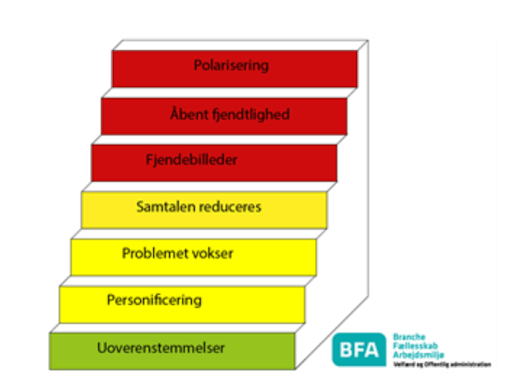
Conflict management
Conflict management in the workplace
Even the most well-functioning teams and collaborations can lead to conflict. We know this because we work with large and medium-sized organisations on a daily basis, with a special focus on conflict management in the workplace. In a day with Team development with us you can use fun team exercises to strengthen your communication and relationships across the organisation - all to ensure that the conflicts that inevitably arise are handled appropriately.
Our Team Development takes place in one of our Mystery Rooms, where we use our experience and expertise to challenge and advise teams in their workplace conflict management. And let's get back to the topic of this article, which is proper conflict management in the workplace.
Conflict can be the bridge to another person
Conflict is a natural part of any workplace, but it's how these conflicts are handled that can make a crucial difference in the working environment among your employees. In this article, we'll explore what conflict management in the workplace is and also introduce a number of effective dialogue tools that can hopefully help build the right bridge between employees.
Before we dive deeper into conflict management in the workplace, it's important to understand what conflict actually is. On a lexical level, it is a clash between two parties.
A clash doesn't sound like a good thing, of course, but if handled correctly, it can actually provide both parties with new insights and create internal development within the team. The important thing to remember is that the conflict is not between the parties, but rather from the parties towards the problem. We'll come back to this point later, but first let's introduce one of the many tools available for identifying and tackling conflict. Conflict resolution in the workplace is all about being constructive, and what could be more constructive than a staircase?
Conflict stairs
The Conflict Ladder is an effective tool for evaluating how to handle a conflict appropriately and correctly. The ladder illustrates how conflicts escalate and presents some solution ideas for each step. It is a useful model to refer to collectively in the workplace when you want to discuss how far a conflict has progressed.
It's rare that all parties to the conflict have a common understanding of when the conflict has started or is starting, or what has caused or is causing it. However, there is often agreement on where the conflict is on the staircase.
It can serve as a good starting point to discuss what is needed to de-escalate the conflict and avoid escalating it further. The conflict ladder is one of many effective dialogue tools.
Below we will introduce a more conversation-based dialogue tool that can help parties manage conflict by creating greater clarity around the problem.

Building bridges between people happens through good conversation
Building bridges between people is about creating connections and understanding, even in times of conflict. This can be achieved by using dialogue tools that promote effective communication and conflict resolution. Below we've listed four methods that can facilitate good communication between parties:
- Active listening
- Empathy
- Open questions
- Neutral third party
Active listening
Active listening involves giving full attention to the other person's views without interrupting or judgement. Active listening not only shows respect for the other person, but it also opens up a more constructive conversation where you can both be heard and understood.
Empathy
Putting yourself in the other person's shoes can be a great tool for resolving conflict. You can do this by empathising and trying to understand the other party's perspective and feelings. This can break down barriers and create a more positive climate where the other party feels seen.
Open questions
Asking open-ended questions invites a conversation where there is an opportunity to deepen your views. Therefore, ask open questions to deepen the understanding of the conflict. Having open-ended conversations allows for an exchange of ideas and eventually an opportunity to find a common solution.
Neutral third party
A neutral third party can help facilitate the conversation and ensure that both parties have the opportunity to express themselves. This could be a manager or an external conflict resolution professional.
Preventing future conflicts
In addition to resolving existing conflicts, it's also crucial to prevent future conflicts, and with our Team development help you with. Conflict management in the workplace is about more than just resolving disagreements.
It's about building bridges between people through effective dialogue tools. Active listening, empathy, open conversations and a neutral third party are the keys to managing conflict constructively.
By investing time and resources in conflict management, organisations can create a more harmonious work environment that promotes both productivity and collaboration. At Mystery Makers, we help many organisations identify their pitfalls in a team through fun team exercises. If you want to read more about it, you can read about our Team development or fill out our contact form.